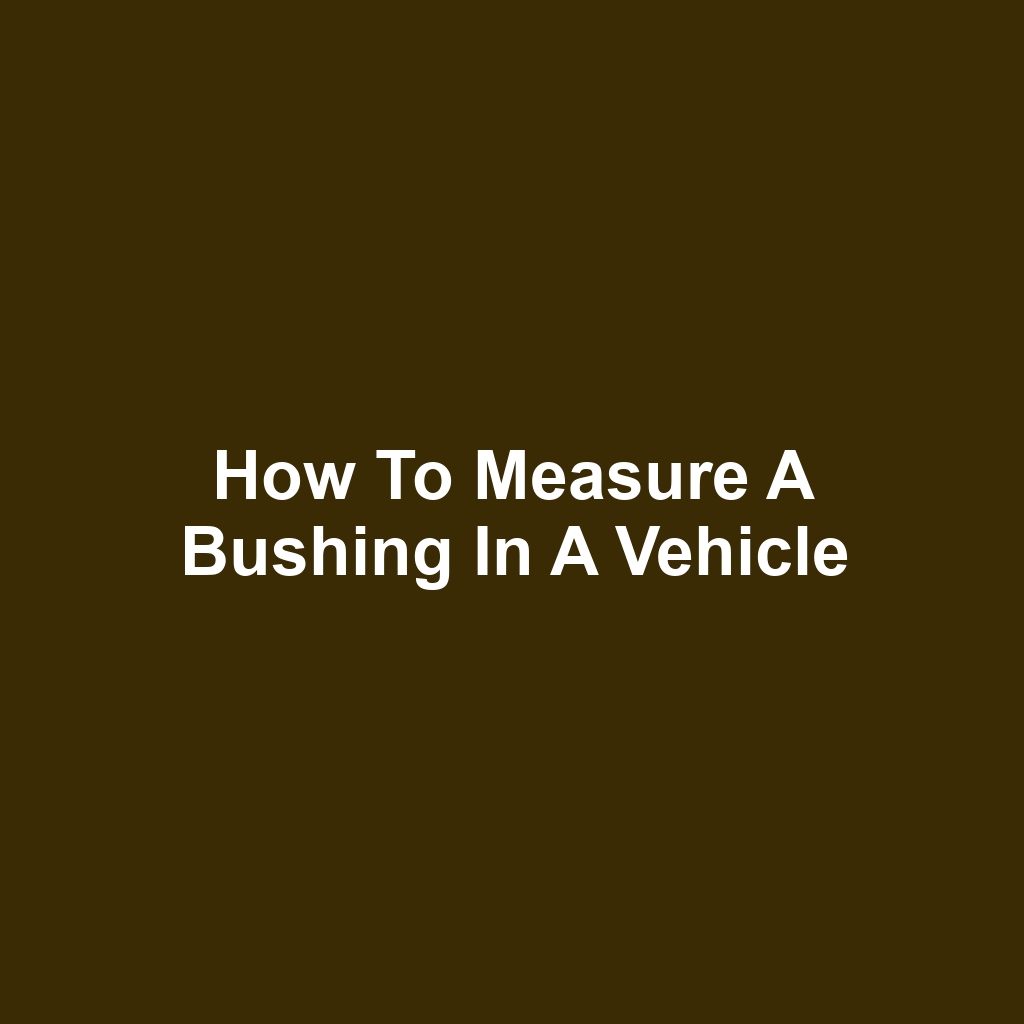When it comes to maintaining a vehicle, understanding how to measure a bushing is essential. Many car enthusiasts and mechanics alike often overlook this crucial component, but it plays a significant role in suspension and alignment. By knowing the right techniques, one can ensure a proper fit for replacements, enhancing the vehicle’s performance. This guide will walk readers through the necessary tools, identifying bushing types, and taking accurate measurements. With a little attention to detail, they’ll be well on their way to getting their vehicle back in optimal shape.
Tools Required for Measurement
For measuring a bushing in a vehicle, they’ll need tools like calipers, micrometers, and a ruler. Calipers provide precise measurements, ensuring accuracy in the bushing’s diameter. Micrometers offer even finer measurements, particularly for smaller dimensions. A ruler can help in measuring the overall length of the bushing. They’ll also want a flashlight to inspect the bushing for any wear or damage. A torque wrench could be useful if the bushing is part of a bolted assembly. They’ll need a notebook to record the measurements taken during the process. Safety glasses should be worn to protect their eyes while working. Lastly, having a digital measuring tool can enhance accuracy even more.
Identifying the Bushing Type
Identifying the bushing type can significantly affect the accuracy of the measurements taken during the inspection process. Different vehicles utilize various bushing types, such as rubber, polyurethane, or even metal. Each type has distinct characteristics that influence how they wear and behave under stress. Mechanics often rely on their experience to recognize these types quickly. It’s crucial for them to be familiar with the specific bushing designs used in different vehicle makes and models. Visual inspection can sometimes reveal the material used, but deeper analysis might be necessary for accurate identification. For example, rubber bushings typically appear softer and more flexible, while polyurethane ones are denser and firmer. Additionally, some vehicles may incorporate unique hybrid bushings that combine different materials. Ultimately, incorrect identification can lead to improper measurements and, consequently, inaccurate repairs.
Measuring Outer Diameter
Measuring the outer diameter requires a caliper to ensure precision in the dimensions. It’s important to place the caliper jaws around the bushing without any obstruction. They should ensure that the caliper is perpendicular to the bushing’s surface. When the measurement is taken, they need to read the scale carefully. A digital caliper can provide a more straightforward reading for accuracy. If using a manual caliper, it’s crucial to minimize parallax error. Once the measurement is noted, they should compare it to the specifications. Any discrepancies might indicate the need for replacement. Finally, recording these measurements will aid in future maintenance.
Measuring Inner Diameter
The inner diameter of the bushing needs to be determined accurately to ensure proper fit and function. Typically, a caliper’s used to take the measurement, providing precise results. The technician should insert the caliper’s tips into the inner bore of the bushing. They’ll then gently expand the caliper until it makes contact with both sides. Once in position, they’ll read the measurement displayed on the caliper. It’s crucial to take multiple readings at different points to account for any irregularities. After obtaining the average measurement, it’s wise to compare it with the manufacturer’s specifications. If the measurement’s inconsistent, it may indicate wear or damage. This process helps maintain the integrity of the vehicle’s components.
Checking Width and Thickness
Checking the width and thickness of a bushing ensures it fits properly within the vehicle’s components. He’ll need a caliper or micrometer for accurate measurements. Once the tool is ready, he’ll position it around the bushing to determine its width. After measuring, he’ll record the value to compare against manufacturer specifications.
Next, he’ll measure the thickness by placing the tool perpendicular to the bushing. It’s crucial for him to ensure that the tool’s jaws are snug against the bushing for an accurate reading. If the width or thickness deviates from the specifications, it could lead to performance issues. He should also check for any wear or deformities that might affect the bushing’s fit. Proper measurements will help maintain the integrity of the vehicle’s components.
Recording Measurements for Replacement
When it comes to recording measurements for replacement, it’s crucial to have the right approach. He’ll need to gather the necessary tools and ensure each dimension is taken accurately. With the measurements noted, he can then move on to the specifics required for a successful replacement.
Tools Required for Measurement
Having the right tools for measurement makes all the difference in achieving precise results. He’ll need a caliper to measure the inner and outer diameters accurately. A micrometer can provide even more precision for smaller dimensions. A tape measure is essential for longer measurements, ensuring nothing’s overlooked. Finally, a depth gauge will help him capture the bushing’s depth with confidence.
Taking Accurate Dimensions
Taking accurate dimensions ensures that he won’t encounter issues during the replacement process. He’ll measure the inner diameter, outer diameter, and length of the bushing to ensure a precise fit. Each measurement needs to be double-checked to avoid any discrepancies. After recording the dimensions, he’ll compare them with the specifications of the new bushing. This careful attention to detail will facilitate a smoother installation.
Noting Measurement Specifications
Noting measurement specifications is essential for ensuring compatibility with the replacement parts he’s considering. He’ll want to document the inner diameter, outer diameter, and length of the bushing accurately. After that, it’s important to check for any specific tolerances that might be required. He should also take note of the material type, as it can affect the bushing’s performance. Lastly, referencing the vehicle’s specifications can provide additional guidance for the measurement process.
If you’re looking for practical tips on vehicle safety, you might want to check out how to lock your Kia Telluride while it’s running. This useful guide not only enhances your convenience but also ensures your vehicle remains secure in any situation. For more information, visit [how to lock kia telluride while running]
